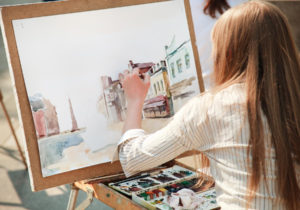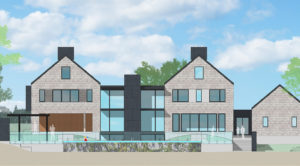‘I’ve got this drawing’: Composition in architecture and painting
 From the earliest cave painters to Matisse and beyond, almost every painter creates a composition. Composition in architecture and painting is simply the arrangement of the creative work’s elements in the given space. This matters because, in painting for example, the canvas presents a flat surface and the painter doesn’t want the viewer’s eye to stop and stay in just one place or, worse, to look away. There are many different techniques that artists use to create visual interest in their work and help the eye move around the surface. Lines, shapes, colors, textures, light and dark; placement of forms; and manipulation of space around them all can all help achieve the desired effect. Pick almost any painting from any era and you will see this illustrated. What people find most appealing tend to be paintings where there is not just one focal point, but rather the eye moves on to another and another. There’s a lot to absorb, to experience.
From the earliest cave painters to Matisse and beyond, almost every painter creates a composition. Composition in architecture and painting is simply the arrangement of the creative work’s elements in the given space. This matters because, in painting for example, the canvas presents a flat surface and the painter doesn’t want the viewer’s eye to stop and stay in just one place or, worse, to look away. There are many different techniques that artists use to create visual interest in their work and help the eye move around the surface. Lines, shapes, colors, textures, light and dark; placement of forms; and manipulation of space around them all can all help achieve the desired effect. Pick almost any painting from any era and you will see this illustrated. What people find most appealing tend to be paintings where there is not just one focal point, but rather the eye moves on to another and another. There’s a lot to absorb, to experience.
Rich and interesting composition
The same elements of composition should apply to works of architecture. Each façade of a building is primarily two-dimensional. Good building elevations have repetition and rhythm, yet there are interruptions, areas of special focus, light and dark, changes in color or texture. As a result, you don’t fully understand and appreciate at one glance the building elevation. Instead, you need to absorb what the architect has put into the composition.
At architecture school, we focus on this lesson in the early studios because it’s difficult to apply, even for the best students. They tend to start with linear compositions; we work with them to make their compositions richer and more interesting.
Inside and outside composition linked
The other thing about an exterior elevation is that it is a reflection of what’s happening inside the building. This is probably the most challenging aspect for non-architects. You might do a wonderful sketch of what you want your house to look like, but it will likely be an exterior only.
There won’t be any mapping to what’s inside that window or dormer. Or you may have the interior layout you want, but how does that look from outside the house? Students go through many years of training to command this aspect of architecture.
The openings — the windows and doors — reflect the function behind that wall. A living room window will look different from a bedroom window, which looks different from a bathroom window. The facade expresses what’s inside. The reverse may not hold true. Interior functions don’t necessarily lead to expression on the outside. (The office window may look like that of the living room.)
 Variation creates interest
Variation creates interest
What if the function inside is very repetitive? For example, identical apartments or patient rooms in a hospital, one after another — dozens, even hundreds. This leads to a very repetitive facade because of the repetition of function. The challenge is to find or create variations, exceptions to the norm. These could be places where people congregate, but they will reflect interior spaces that are exceptions to that repeated function.
Often, it’s necessary to manipulate the interior spaces to create a more interesting exterior elevation. (It’s not just a floor plan plus, separately, what you want the exterior to look like.) We rearrange the atypical spaces to manipulate the facade.
Sometimes people come to us and say, “We want a center hall colonial or a Greek revival, something very symmetrical.” For these homes, it’s the details and subtle shifts in proportion that create the interest and make them worth that second, third, and fourth glance.
For example, the first floor is often taller than the second floor. Or, the house may be symmetrical right to left, but there’s variety from top to bottom. There’s needs to be a strong emphasis on how the building meets the ground and on how it meets the sky.
Ornamentation yields discovery
In addition to vertical variations in the composition, there is the ornamentation around the openings, and the variation in materials. We are seeking the balance between order and disorder, between plan and elevation, function and aesthetic. If it’s balanced left to right, then we want to introduce something more interesting vertically. When it’s all said and done, you want to be able to “discover” something about a building.
Viewing distance should matter
There is also the matter of distance. When you’re far away, you have one perception, but that should change as you get closer; there is a middle ground where you begin to see newer elements, then close against the building, there is a tactile sense.
End game: Enduring interest
So we can create interest not only with 2D composition in architecture, such as the painter adopts, but also in the third dimension. We especially want to create objects and compositions that have an enduring interest. They’re not one-liners in which you’ve seen it from a distance and you understand it all. There’s a value to well-thought-out composition. This is a place you want to keep coming back to, where there is interest and complexity — where you’ll live your life. You aren’t one dimensional or even two dimensional; people are complex, just as their houses should be.